- Home
- Michael Pollan
The Omnivore's Dilemma
The Omnivore's Dilemma Read online
Table of Contents
Title Page
Copyright Page
Dedication
Introduction
PART I - The Industrial Meal: Food from Corn
Chapter 1 - HOW Corn Took Over America
Chapter 2 - The Farm
Chapter 3 - From Farm to Factory
Chapter 4 - THE GRAIN ELEVATOR
Chapter 5 - The Feedlot—Turning Corn into Meat
Chapter 6 - Processed Food
Chapter 7 - Fat from Corn
Chapter 8 - The Omnivore’s Dilemma
Chapter 9 - My Fast-Food Meal
PART II - The Industrial Organic Meal
Chapter 10 - Big Organic
Chapter 11 - More Big Organic
PART III - The Local Sustainable Meal: Food from Grass
Chapter 12 - Poly face Farm
Chapter 13 - Grass
Chapter 14 - The Animals
Chapter 15 - The Slaughterhouse
Chapter 16 - The Market
Chapter 17 - My Grass-Fed Meal
PART IV - The Do-It-Yourself Meal: Hunted, Gathered, and Gardened Food
Chapter 18 - The Forest
Chapter 19 - Eating Animals
Chapter 20 - Hunting
Chapter 21 - Gathering
Chapter 22 - The Perfect Meal
The Omnivore s’Solution: Some Tips for Eating
Q&A with Michael Pollan
FURTHER RESOURCES
Acknowledgements
DIAL BOOKS
An imprint of Penguin Group (USA) Inc.
Published by The Penguin Group
Penguin Group (USA) Inc., 375 Hudson Street, New York, NY 10014, U.S.A.
Penguin Group (Canada), 90 Eglinton Avenue East, Suite 700, Toronto, Ontario,
Canada M4P 2Y3 (a division of Pearson Penguin Canada Inc.)
Penguin Books Ltd, 80 Strand, London WC2R 0RL, England
Penguin Ireland, 25 St. Stephen’s Green, Dublin 2, Ireland (a division of Penguin Books Ltd)
Penguin Group (Australia), 250 Camberwell Road, Camberwell, Victoria 3124, Australia
(a division of Pearson Australia Group Pty Ltd)
Penguin Books India Pvt Ltd, 11 Community Centre, Panchsheel Park,
New Delhi-110 017, India
Penguin Group (NZ), 67 Apollo Drive, Rosedale, North Shore 0632, New Zealand
(a division of Pearson New Zealand Ltd)
Penguin Books (South Africa) (Pty) Ltd, 24 Sturdee Avenue, Rosebank,
Johannesburg 2196, South Africa
Penguin Books Ltd, Registered Offices: 80 Strand, London WC2R 0RL, England
Copyright © 2009 by Michael Pollan
eISBN : 978-1-101-14876-1
1. Food supply—Juvenile literature. 2. Food chains
(Ecology)—Juvenile literature. I. Pollan, Michael. Omnivore’s dilemma.
II. Title. III. Title: Secrets behind what you eat.
HD9000.5.C506 2009
338.10973—dc22
2009009283
http://us.penguingroup.com
For Judith and Isaac
INTRODUCTION
Before I began working on this book, I never gave much thought to where my food came from. I didn’t spend much time worrying about what I should and shouldn’t eat. Food came from the supermarket and as long as it tasted good, I ate it.
Until, that is, I had the chance to peer behind the curtain of the modern American food chain. This came in 1998. I was working on an article about genetically modified food—food created by changing plant DNA in the laboratory. My reporting took me to the Magic Valley in Idaho, where most of the french fries you’ve ever eaten begin their life as Russet Burbank potatoes. There I visited a farm like no farm I’d ever seen or imagined.
It was fifteen thousand acres, divided into 135-acre crop circles. Each circle resembled the green face of a tremendous clock with a slowly rotating second hand. That sweeping second hand was the irrigation machine, a pipe more than a thousand feet long that delivered a steady rain of water, fertilizer, and pesticide to the potato plants. The whole farm was managed from a bank of computer monitors in a control room. Sitting in that room, the farmer could, at the flick of a switch, douse his crops with water or whatever chemical he thought they needed.
One of these chemicals was a pesticide called Monitor, used to control bugs. The chemical is so toxic to the nervous system that no one is allowed in the field for five days after it is sprayed. Even if the irrigation machine breaks during that time, farmers won’t send a worker out to fix it because the chemical is so dangerous. They’d rather let that whole 135-acres crop of potatoes dry up and die.
That wasn’t all. During the growing season, some pesticides get inside the potato plant so that they will kill any bug that takes a bite. But these pesticides mean people can’t eat the potatoes while they’re growing, either. After the harvest, the potatoes are stored for six months in a gigantic shed. Here the chemicals gradually fade until the potatoes are safe to eat. Only then can they be turned into french fries.
That’s how we grow potatoes?
I had no idea.
A BURGER WITH YOUR FRIES?
A few years later, while working on another story, I found myself driving down Interstate 5, the big highway that runs between San Francisco and Los Angeles. I was on my way to visit a farmer in California’s Central Valley. It was one of those gorgeous autumn days when the hills of California are gold. Out of nowhere, a really nasty smell assaulted my nostrils—the stench of a gas station restroom sorely in need of attention. But I could see nothing that might explain the smell—all around me were the same blue skies and golden hills.
And then, very suddenly, the golden hills turned jet-black on both sides of the highway: black with tens of thousands of cattle crowded onto a carpet of manure that stretched as far as the eye could see. I was driving through a feedlot, with tens of thousands of animals bellying up to a concrete trough that ran along the side of the highway for what seemed like miles. Behind them rose two vast pyramids, one yellow, the other black: a pile of corn and a pile of manure. The cattle, I realized, were spending their days transforming the stuff of one pile into the stuff of the other.
This is where our meat comes from?
I had no idea.
Suddenly that “happy meal” of hamburger and fries looked a lot less happy. Between the feedlot and the potato farm, I realized just how little I knew about the way our food is produced. The picture in my head, of small family farms with white picket fences and red barns and happy animals on green pastures, was seriously out of date.
THE OMNIVORE’S DILEMMA
Now I had a big problem. I went from never thinking about where my food came from to thinking about it all the time. I started worrying about what I should and shouldn’t eat. Just because food was in the supermarket, did that mean it was good to eat?
The more I studied and read about food the more I realized I was suffering from a form of the omnivore’s dilemma. This is a big name for a very old problem. Human beings are omnivores. That means we eat plants, meat, mushrooms—just about anything. But because we are omnivores we have very little built-in instinct that tells us which foods are good for us and which aren’t. That’s the dilemma—we can eat anything, but how do we know what to eat?
The omnivore’s dilemma has been around a long time. But today we have a very modern form of this dilemma. We have a thousand choices of food in our supermarkets, but we don’t really know where our food comes from. As I discovered, just finding out how our potatoes are grown might scare you off french fries for the rest of your life.
In the past, people knew about food because they grew it or hunted it themselves. They learned about food fro
m their parents and grandparents. They cooked and ate the same foods people in their part of the world had always eaten. Modern Americans don’t have strong food traditions. Instead we have dozens of different “experts” who give us lots of different advice about what to eat and what not to eat.
It’s one thing to be crazy about food because you like to eat. But I found I was going crazy from worrying about food. So I set out to try to solve the modern omnivore’s dilemma. I decided to become a food detective, to find out where our food comes from and what exactly it is we are eating. My detective work became the book you now hold in your hands.
FOUR MEALS
As a food detective, I had to go back to the beginning, to the farms and fields where our food is grown. Then I followed it each step of the way, and watched what happened to our food on its way to our stomachs. Each step was another link in a chain—a food chain.
A food chain is a system for growing, making, and delivering food. In this book, I follow four different food chains. Each one has its own section. They are:Industrial
This is where most of our food comes from today. This chain starts in a giant field, usually in the Midwest, where a single crop is grown—corn, or perhaps soybeans—and ends up in a supermarket or fast-food restaurant.
Industrial Organic
This food is grown on large industrial farms, but with only natural fertilizers, and natural bug and weed control. It is sold in the same way as industrial food.
Local Sustainable
This is food grown on small farms that raise lots of different kinds of crops and animals. The food from the farm doesn’t need to be processed, and it travels a short distance—to a farmer’s market, for example—before it reaches your table.
Hunter-Gatherer
This is the oldest type of food chain there is. It’s hardly a chain at all, really. It is made up simply of you, hunting, growing, or finding your food.
All these food chains end the same way—with a meal. And so I thought it important to end each section of the book with a meal, whether it was a fast-food hamburger eaten in a speeding car, or a meal I made myself from start to finish.
THE PLEASURES OF EATING
When I was ten years old, I started my own “farm” in a patch of our backyard. From that age until now, I have always had a vegetable garden, even if only a small one. The feeling of being connected to food is very important to me. It’s an experience that I think most of us are missing today. We’re so confused about food that we’ve forgotten what food really is—the bounty of the earth and the power of the sun captured by plants and animals.
There were parts of this book that were difficult to write, because the facts were so unpleasant. Some of those facts might make you lose your appetite. But the point of this book is not to scare you or make you afraid of food. I think we enjoy food much more if we take a little time to know what it is we’re putting in our mouths. Then we can really appreciate the truly wonderful gifts that plants and animals have given us. To me, that’s the point of this book, to help you rediscover the pleasures of food and learn to enjoy your meals in a new way.
PART I
The Industrial Meal: Food from Corn
1
HOW Corn Took Over America
A FIELD OF CORN
The average supermarket doesn’t seem much like a field of corn.
Take a look around one. What do you see? There’s a large, air-conditioned room. There are long aisles and shelves piled high with boxes and cans. There are paper goods and diapers and magazines. But that’s not all. Look again. Somewhere, behind the brightly colored packaging, underneath the labels covered with information, there is a mountain of corn.
You may not be able to see it, but it’s there.
I’m not talking about the corn in the produce section. That’s easy to recognize. In the spring and summer, the green ears of corn sit out in plain view with all the other fruits and vegetables. You can see a stack of ears next to the eggplants, onions, apples, bananas, and potatoes. But that’s not a mountain of corn, is it?
Keep looking. Go through produce to the back of the supermarket and you’ll find the meats. There’s corn here too, but it’s a little harder to see. Where is it? Here’s a hint: What did the cows and pigs and chickens eat before they became cuts of meat? Mainly corn.
Go a little further now. There’s still a lot of corn hiding in this supermarket. How about those long aisles of soft drinks? Made from corn. That freezer case stuffed with TV dinners? Mostly corn. Those donuts and cookies and chips? They’re made with a whole lot of corn.
Supermarkets look like they contain a huge variety of food. The shelves are stuffed with thousands of different items. There are dozens of different soups and salad dressings, cases stuffed with frozen dinners and ice cream and meat. The range of food choices is amazing.
Yet if you look a little closer, you begin to discover:
It’s All Corn.
Well, maybe not all corn, but there’s still an awful lot of it hiding here—a lot more than you suspect. We think of our supermarkets as offering a huge variety of food. Yet most of that huge variety comes from one single plant. How can this be?
Corn is what feeds the steer that becomes your steak.
Corn feeds the chicken and the pig.
Corn feeds the catfish raised in a fish farm.
Corn-fed chickens laid the eggs.
Corn feeds the dairy cows that produce the milk, cheese, and ice cream.
See those chicken nuggets in the freezer case? They are really corn wrapped up in more corn. The chicken was fed corn. The batter is made from corn flour. The starch that holds it together is corn starch. The oil it was fried in was corn oil.
But that’s not all. Read the label on any bag of chips, candy bar, or frozen snack. How many ingredients do you recognize? Maltodextrin? Monosodium glutamate? Ascorbic acid? What are those things? What about lecithin and mono-, di-, and triglycerides? They are all made from corn. The golden food coloring? Made from corn. Even the citric acid that keeps the nugget “fresh” is made from corn.
If you wash down your chicken nuggets with almost any soft drink, you are drinking corn with your corn. Since the 1980s almost all sodas and most of the fruit drinks sold in the supermarket are sweetened with something called high-fructose corn syrup.
Read the label on any processed food, and corn is what you’ll find. Corn is in the non-dairy creamer and the Cheez Whiz, the frozen yogurt and the TV dinner, the canned fruit and the ketchup. It’s in the candy, the cake mixes, the mayonnaise, mustard, hot dogs and bologna, the salad dressings and even in some vitamins. (Yes, it’s in a Twinkie too.)
There are some forty-five thousand items in the average American supermarket and more than a quarter of them now contain corn. This goes for the non-food items as well—everything from toothpaste and cosmetics to disposable diapers, trash bags, and even batteries.
Corn is in places you would never think to look. It’s in the wax that coats the other vegetables in the produce section. It goes into the coating that makes the cover of a magazine shine. It’s even part of the supermarket building, because the wallboard, the flooring, and many other building materials are made with corn.
CARBON FROM CORN
You are what you eat, it’s often said. If this is true, then what we are today is mostly corn. This isn’t just me being dramatic—it’s something that scientists have been able to prove. How do they do this? By tracing the element carbon as it goes from the atmosphere into plants, then into our food, and finally, into us.
You may have heard the expression that humans are a carbon-based life form. (This always seems to come up in science fiction movies, but it’s true.) Like hydrogen and oxygen, carbon is an element, one of the basic building blocks of matter. All the molecules that make up our cells—carbohydrates, proteins, and fats—contain the element carbon.
All of the carbon in our bodies was originally floating in the air, as part of a carbon dioxide molecule.
Plants take the carbon out of carbon dioxide and use it to make food—carbohydrates. They do this through a process called photosynthesis. In photosynthesis, plants use the energy of the sun (photo means light) to synthesize (make) food.
All of our food, in fact almost all life on earth, can be traced back to photosynthesis in plants. It’s more than a figure of speech to say that plants create life out of thin air.
All food begins with the process of photosynthesis.
So the plants take carbon and make it into food. Then we eat the plants, or we eat animals that have eaten the plants. That’s how the carbon winds up in our cells. But not all carbon is the same. Corn uses slightly different types of carbon than other plants. So by looking at the type of carbon in our cells, scientists can tell how much corn we have been eating.
Todd Dawson, a biologist at the University of California, Berkeley, has done exactly that kind of research. He says that when you look at the carbon in the average American’s cells, “we look like corn chips with legs.”
Americans don’t think of themselves as corn eaters. Our bread is made from wheat flour. We don’t eat a lot of corn on the cob. When we think of serious corn eaters, we often think of people in Mexico. About 40 percent of their calories come directly from corn, mostly in the form of corn tortillas. Yet Americans have more corn in our diet than Mexicans. It’s just that the corn we eat wears many different disguises.
How did corn take over America? It’s really a tremendous success story—for corn, anyway. Corn has managed to become the most widely planted crop in America—more than 80 million acres of farmland are planted with corn every year. Today it covers more acres of the country than any other living species, including human beings. It has pushed other plants and animals off the American farm. It has even managed to push a lot of farmers off the farm. (I’ll explain that one later.) Corn is now one of the most successful plants on earth.

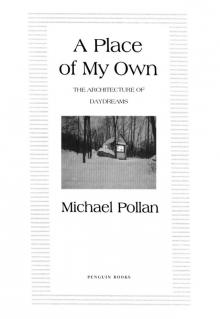 A Place of My Own: The Education of an Amateur Builder
A Place of My Own: The Education of an Amateur Builder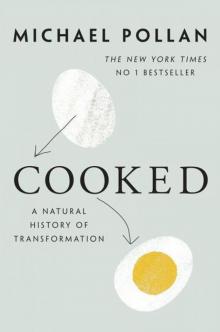 Cooked: A Natural History of Transformation
Cooked: A Natural History of Transformation The Omnivore's Dilemma
The Omnivore's Dilemma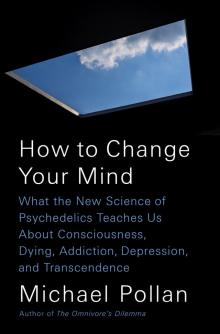 How to Change Your Mind
How to Change Your Mind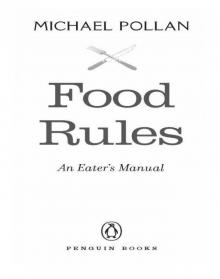 Food Rules
Food Rules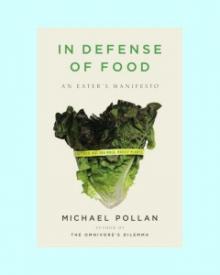 In Defense of Food
In Defense of Food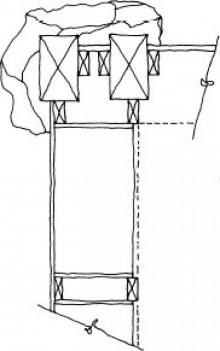 A Place of My Own
A Place of My Own